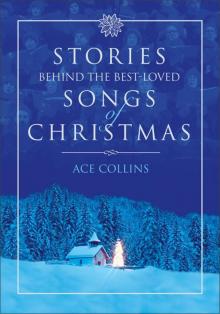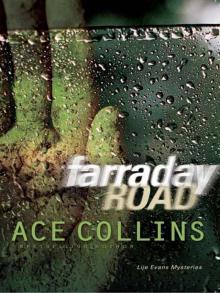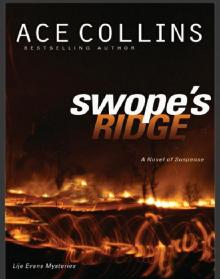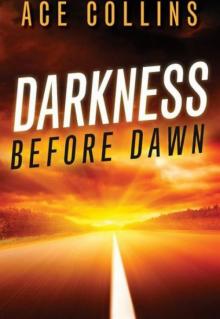- Home
- Ace Collins
Stories Behind the Best-Loved Songs of Christmas Page 7
Stories Behind the Best-Loved Songs of Christmas Read online
Page 7
The real world kept Niles from that quest for some time. To make ends meet, John worked for an adding machine company, then served as a pilot during World War I. It was during his days in Europe that he first put together an impressive catalog of American folk songs. Begging every soldier he met to share a song, Niles wrote down the lyrics and memorized the music of each one. After the war, armed with a suitcase filled with folk music, Niles returned home and continued his education at the Cincinnati Conservatory. When he graduated he moved to Chicago, where he sang with the Lyric Opera and performed on Westinghouse Radio.
In 1925 Niles moved to New York, where he not only sang on radio and stage, but also began to publish music collections of both his original songs and the folk songs he had gathered during the war. By 1940 he was a recording artist on the RCA label and was recognized as one of the nation’s top opera singers. His two most successful original works were “Black is the Color of My True Love’s Hair” and “Jesus, Jesus, Rest Your Head.” Money and fame had made Niles the toast of New York. Yet even as he received standing ovations for singing the best in classical music in front of crowds, dressed in the finest clothing, backstage the man sang folk ditties. There was something about simple American music that just wouldn’t leave him alone.
Deciding he was more historian than performer, Niles moved home to Kentucky. With the advent of radio and the automobile, rural music and the traditions that went with it were quickly fading. So in his beloved Appalachian Mountains, Niles spent a good portion of the remainder of his life traveling from town to town, looking for undiscovered folk songs. The library of work he uncovered is one of the most important in music history. One song in particular would become a monument to Niles’s years of hard work and a testament to the power of inspired creativity.
On a cold December day in North Carolina, Niles observed people from a poor community going about their daily lives. From his own experience, Niles knew that just a few hundred miles away in New York, people crowded the gaily decorated city streets, stores could not hold all the eager shoppers armed with lists, and holiday music blared from long rows of loudspeakers. Yet in this village he could hear the sound of snow crunching under feet and spy children in ragged clothes looking longingly into windows where a few small toys were displayed. It was as if the modern world had never found this unspoiled place.
While Niles took in the pastoral scene that surrounded him, a solitary voice beckoned ever so faintly. Searching the street, his eyes honed in on a small girl sitting by herself on a bench. Unaware she had an audience, the child was softly singing a song Niles had never heard.
When she finished, the curious songwriter reached into his pocket and pulled out a pencil and tablet. Approaching the little girl, he introduced himself, sat down and then asked about the song. All she knew about it was that her mother had taught it to her, like her grandma had taught it to her mother before her. When asked to sing it again, the red-cheeked youngster smiled and quietly repeated the ballad’s short verses.
The song, which the girl called “I Wonder as I Wander,” haunted Niles. Long after the child disappeared into the evening, the man continued to study the words. They were unlike any he had ever uncovered in his long search for folk music. Deeply spiritual, incredibly thoughtful, yet obviously composed by someone of little means and education, the lyrics embraced the joy and wonder of Christmas but also lingered on the sacrifice of a child grown into a man that died on a cross. The soaring happiness, combined with unparalleled sorrow, seemed to share the elements of Negro spirituals with the irony of Irish ballads. Both the words and music were perfect, simple, direct, and inspired. Even a master songwriter like Niles couldn’t imagine improving on them. “Where did it come from?” he wondered as he returned home.
I wonder as I wander out under the sky,
How Jesus the Savior did come for to die.
For poor on’ry people like you and like I.
I wonder as I wander out under the sky.
When Mary birthed Jesus ‘twas in a cow’s stall,
With wise men and farmers and shepherds and all.
But high from God’s heaven a star’s light did fall,
And the promise of ages it then did recall.
If Jesus had wanted for any wee thing,
A star in the sky, or a bird on the wing,
Or all of God’s angels in heav’n for to sing,
He surely could have it, ‘cause he was the King.
When Niles brought the song to prominence just before the beginning of World War II, he tried to capture the spirit of the child who had first shared the song with him. Even as he awed audiences with his discovery, the humble singer recognized that his version was not nearly as powerful as the original.
For years, Niles sang “I Wonder as I Wander” and continued to dig into the mystery of the unrecognized genius who composed the carol. It was a quest he pursued until his death in 1980. Yet he could never trace the song back farther than the girl in North Carolina, a child he never found again. It was as if the little one had been an angel sent to deliver a message, a message that embraced the wonder of the Savior’s birth and sacrifice. Because of a chance meeting between an unknown child and a man who spent his life wandering America in search of music, the world gained an unforgettable Christmas ballad that has never ceased to cause those who hear it to wonder.
15
I’LL BE HOME FOR CHRISTMAS
Millions of those who once embraced this song—who reverently listened to each word and note and hung on every sentimental thought woven into the lyrics—are now gone. Age has taken a mighty toll on the men and women who first clung to “I’ll Be Home for Christmas” as not just a song, but also as a prayer. For young and old during the darkest days of World War II, for sons and daughters, fathers and mothers, grandmothers and grandfathers, aunts and uncles, “I’ll Be Home for Christmas” represented their hopes, dreams, and prayers better than any other song, movie, or story. Many who hear this carol today may think it overly maudlin, but when it was released, it quickly became the most powerful song on the hit parade.
The song may very well be one of the simplest Christmas carols ever written. There is an introduction, a single verse and a chorus, just twelve lines that innocently depict a person’s longing for home. Yet the way these dozen lines moved a nation during the uncertain times of war, as well as the way they continue to move people today, makes this secular carol one of the most spiritual songs of any era.
It was 1942, and lyricist Kim Gannon knew the emotional toll of fighting a war on two fronts. In Brooklyn, the writer’s home, not only had thousands of families given up their sons to the armed forces, but many had already lost their children in battle. Christmas, traditionally a time of great joy in Gannon’s New York borough, felt strangely different that year. The streets were decorated, trees were sold on corner lots, and Santas still rang their bells and smiled at children, but the war had cast a pall over the holidays. It was hard to think of presents or peace on earth when parents anxiously read the news and prayed that every telegraph delivery man would pass them by. To make it all worse, no one was completely sure that the United States and its allies could even win the horrible war.
Kim saw the same gut-wrenching scenes play out every day—the prayers of frantic parents, the tears of newly enlisted soldiers saying their good-byes at train stations, the rush toward mailmen who might carry a letter from a loved one. The writer knew well that the news on the radio was both a curse and a blessing. Everyone felt the need to learn what was going on in the Pacific and Europe, but fear came with that knowledge as well…a biting fear when a parent or wife heard that a major battle had broken out in the same place a son, father, or husband had mentioned in their last letter home. With the coming of Christmas, the depression of being separated from loved ones was even worse.
Not only were families of overseas soldiers caught in a world of uncertainty and dread, so were many displaced rural men and women who had moved t
o New York and other large cities to work in plants and offices. Like many of the men in uniform, the war had taken civilians away from home. Most were spending a Christmas away from family for the very first time, and were lonely and homesick.
When Gannon sat down with pen in hand to capture the unsettling scenes that surrounded her and everyone else in America, the cascade of emotions must have made writing “I’ll Be Home for Christmas” very difficult. There was so much to say, so much that would be missed by those split apart by the hellish nightmare of war. Yet rather than try to cover everything, the writer simply wrote, in a straightforward, uncomplicated manner, about the heartache of being away from home at Christmas. Short, direct, and sweet, the poem Kim produced in so few lines somehow completely captured the emotions of hundreds of millions.
Gannon’s words were brought to tunesmith Walter Kent. Also a New Yorker, Kent understood the sadness of the holiday season. Kent, who had already composed the sentimental hit “White Cliffs of Dover,” inherently knew what the song needed. In his mind’s eye, he saw empty chairs at the table, mothers trying to smile through tears as they baked cookies for remaining family members, and unopened presents on the tree. (During this period Christmas presents were often very simple and tied to the tree rather than wrapped and placed under it.) With these pictures firmly set in his mind, he sought to find just the right notes to paint them into a musical score. When he finished his work, he had written a dreamy, hopeful melody that was a perfect fit to Gannon’s words.
One of the true wonders of this song is that it sounds more like a letter home than a typical Christmas carol. Not only is there a real sadness evident in the words and melody, but a hopefulness as well. It’s as if the singer were a homesick marine, soldier, or sailor assuring those who missed him that he would soon be there with them again. Ultimately, “I’ll Be Home For Christmas” left the listener with the final and urgent plea, “Don’t give up, we’ll be together soon.”
The spiritual nature of this song comes from its almost prayer-like message. Christmas in America had always been about family and remembering the One who started it all. Yet World War II had broken those bonds and disturbed the traditions of the holidays. “I’ll Be Home for Christmas” eloquently acknowledged the hope that while things changed, given time, everyone would be home again.
On October 4, 1943, Bing Crosby recorded “I’ll Be Home For Christmas.” It became his 209th charting single and a follow-up to his holiday hit of 1942, “White Christmas.” The latter had stayed on the charts for seventeen weeks during its initial release and reentered the hit parade in 1943 and stayed on there for another month and a half. Yet in the midst of the war, “I’ll Be Home for Christmas” received more airplay and generated more sales than did the Crosby hit of the previous year. It quickly became the most requested song at Christmas U.S.O. shows in both Europe and the Pacific. Some historians have said that for service personnel and their families the only inspirational patriotic song that was its equal was “God Bless America.”
Throughout World War II, Korea, and Vietnam, the song symbolized and captured the emotions of those on the battlefronts, as well as the emotions of those back home praying for their safe return. Recorded countless times by scores of different artists, it has sold millions of records. But beyond its remarkable sales is the way the song has been embraced by every facet of society. As a testament to its hopeful nature, even though it does not have a single reference to Jesus or the first Christmas, over the past fifty years it has been used in hundreds of cantatas and church programs.
Today, more than five decades after it was embraced as a World War II holiday prayer, “I’ll Be Home for Christmas” stirs new emotions. Most of those who returned home for Christmas after the war have left this world for the next. Yet because of the contributions and sacrifices of the men and women who served our country during those dark days, they will always be home for Christmas in our hearts, memories, and dreams.
16
IT CAME UPON THE MIDNIGHT CLEAR
In 1849, a Unitarian minister from Wayland, Massachusetts, was writing a Christmas Eve message for his congregation. As Dr. Edmund Sears worked on his sermon, he was a troubled man. Though it would be another decade before a civil war tore the United States apart, the debate over slavery, compounded by the poverty he saw in his own community, had all but broken the man’s spirit. He desperately searched for words to inspire his congregation, but he was having a problem lifting even his own spirit above the depressing scenes that surrounded him.
Sears, then thirty-nine years old, had been educated at Union College in Schenectady, New York, and at Harvard Divinity School. Though the Unitarian church was known for not exposing the divinity of Christ, Sears preached the divine nature of Jesus in his weekly sermons. He believed that Jesus was the Son of God and had died on the cross for man’s sins. He also believed that every Christian should be involved in reaching out to the lost, helpless, and poor.
In his community Sears was a force of caring in a world that seemed to concern itself little with the traumas of the hungry or the sick. His burden for the helpless forced him to reach out each day to those Christ called “the least of these.” Yet as he worked on writing an uplifting Christmas message, it was the poverty and the hopelessness of the people he touched in the slums that sickened his heart and blocked his progress. He must have wondered how he could write about the Light of the world when the world seemed so very dark.
As Sears struggled, he thumbed through his well-worn Bible. In the second chapter of Luke, the minister was touched by the eighth and ninth verses: “And there were shepherds living out in the fields nearby, keeping watch over their flocks at night. An angel of the Lord appeared to them, and the glory of the Lord shone around them, and they were terrified.” After considering the miraculous nature of that long-ago moment, Sears picked up his pen and jotted down a five-verse poem he called “It Came upon the Midnight Clear.” He then retrieved from his files another Christmas poem he had written a decade before: “Calm on the list’ning ear of night comes heaven’s melodious strains.” Beginning his message with his older Christmas poem, he quickly wrote a short sermon and decided to end his Christmas service with the inspired words of his newest poem.
Today Sears’s poem turned carol is considered joyful and uplifting. Yet when first delivered, its audience probably saw it as more a charge or challenge than the story of a miraculous birth in a faraway land. While the minister wanted his congregation to celebrate Christmas, he also wanted them to reach out to the poor, to address the nation’s social ills, and to consider what they could do as individuals to best reflect the spirit of Christ in their daily lives. In other words, he wanted to see people look to heaven and understand how God needed them to serve man in his name. Nowhere was this message more obvious than in the poem’s second verse, one that has been discarded and all but forgotten.
Yet with the woes of sin and strife The world hath suffered long;
Beneath the angel-strain have rolled Two thousand years of wrong;
And man, at war with man, hears not The love song which they bring:
O hush the noise, ye men of strife, And hear the angels sing!
Not only was the beauty and wonder of the Christmas story woven into a lyrical fabric that was rich and meaningful, but Sears also managed to point out that God, in the form of a child, was entering a world that sorely needed his help. He wanted his congregation and the world to hear those cries as he did.
Since Sears was a magazine and newspaper editor in addition to being a preacher, he had the means to bring his new poem to a wider audience than just his church. The Christian Register, one of the publications for which Sears penned features, printed “It Came upon the Midnight Clear” in its December 29, 1849, issue. Yet, as is so often the case with inspired work, it would take a second man to breathe lasting life into the poem and make it a Christmas classic.
Richard Storrs Willis was a Yale graduate who had been composing cho
ral pieces since his youth. After graduating from college, the native Bostonian furthered his education in Germany in the 1840s by studying with Moritz Liepizi and Felix Mendelssohn. In 1848 he returned to the United States and became the music critic for the New York Tribune.
It came upon the midnight clear,
That glorious song of old,
From angels bending near the earth
To touch their harps of gold:
“Peace on the earth, good will to men,
From heav’n’s all gracious King!”
The world in solemn stillness lay
To hear the angels sing.
Still through the cloven skies they come
With peaceful wings unfurled,
And still their heav’nly music floats
O’er all the weary world:
Above its sad and lowly plains
They bend on hov’ring wing,
And ever o’er its Babel sounds
The blessed angels sing.
And ye, beneath life’s crushing load
Whose forms are bending low,
Who toil along the climbing way
With painful steps and slow,
Look now! for glad and golden hours
Come swiftly on the wing:
O rest beside the weary road
And hear the angels sing.

 Stories Behind the Best-Loved Songs of Christmas
Stories Behind the Best-Loved Songs of Christmas Farraday Road
Farraday Road Yellow Packard
Yellow Packard Swope's Ridge
Swope's Ridge Darkness Before Dawn
Darkness Before Dawn